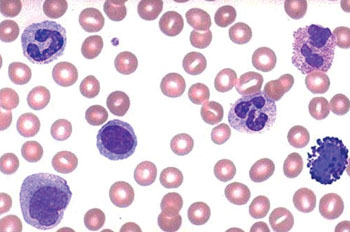Leukocyte Ratio Investigated for Familial Mediterranean Fever Patients
By LabMedica International staff writers
Posted on 28 Apr 2014
Blood neutrophil-to-lymphocyte (N/L) ratio is a simple marker of inflammation that can be easily obtained from the differential leucocyte count and has been used to determine disease activity and diagnosis in patients with ulcerative colitis (UC) and acute appendicitis.Posted on 28 Apr 2014
Familial Mediterranean Fever (FMF) is a recurrent, autosomal recessive autoinflammatory disease characterized with fever and serositis, which is accompanied by pain in the abdominal area, chest, and joints and the disease, is common among Mediterranean communities including Turks, Armenians, Jews, and Arabs.

Image: Stained leukocytes in a peripheral blood smear (Photo courtesy of Dr. Kristine Krafts, MD).
Scientists at the Bozok University Medical School (Yozgat, Turkey) enrolled 115 patients and controls in the study. The cases in the study were categorized as FMF with attack, FMF with attack-free period, and controls. There were 79 patients with FMF and 36 control subjects. There were 29 females and 50 males in the FMF group and 12 females and 24 males in the control group. The data collected included erythrocyte sedimentation rate (ESR), C-reactive protein (CRP), total white blood cell count (WBC), neutrophil counts, lymphocyte counts, and number of platelets.
The median disease duration in FMF patients was 10 years and age and sex were similar in the FMF and control groups. The ESR was significantly higher in FMF patients during the attack phase. The CRP increased during attack but this was not statistically significant and WBC counts did not differ among groups. The mean N/L ratios of the controls was 1.63 (range: 1.41 to 2.33), for FMF patients who were attack- free the ratio was 1.83 (range 1.21 to 2.23), and for FMF patients during attack it was 2.95 (range: 1.91 to 3.46). The serum N/L ratios of FMF patients during attack were significantly higher than those of attack-free FMF patients and controls. While the serum neutrophil count increased in FMF patients during attack, in attack-free FMF patients and controls, the serum lymphocyte count did not differ.
The authors concluded that the N/L ratio, an indicator of the overall inflammatory status of the body, is higher in active FMF patients than in FMF patients in remission and healthy controls. A cut-off ratio value of 2.63 can be used to identify patients with active FMF. N/L ratio is not related with disease duration and inflammatory markers such as CRP and ESR in FMF patients. It is an inexpensive and readily available measure that could in combination with other markers help identify patients with active disease. The study was published on March 28, 2014, in the Journal of Clinical Laboratory Analysis.
Related Links:
Bozok University Medical School













